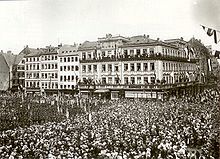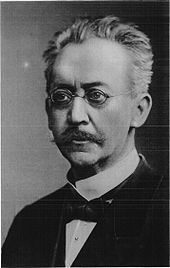Cultural Protestantism
The cultural Protestantism was a flow of Protestant intellectual life in Germany during the decades from 1860 to the inter-war period .
term
Cultural Protestantism began around 1860 - with the profound social change of this time - in theology, church and spiritual life. It reached its peak in the decade around 1900. The First World War marked the end of the Wilhelmine era , but there was also a diverse, albeit ecclesiastically and culturally less influential cultural Protestant movement in German-speaking Protestantism and the Evangelical Church in the 1920s and 1930s. A characteristic of cultural Protestantism is the endeavor to bring the Christian religion into harmony with the general development of culture.
Origin and classification in the history of religion
The theologian Albrecht Ritschl is considered the "father of cultural Protestantism". For him, ethical action was part of the path to the kingdom of God , which was interpreted as an adaptation to the respective human reality. Some of Ritschl's students later became spokesmen for cultural Protestantism ( Martin Rade , Adolf Harnack and Ernst Troeltsch ).
In terms of religious history, cultural Protestantism belongs to New Protestantism , a movement whose representatives wanted to break Protestantism out of church and dogmatic ties and transform it into a modern educational religion beyond denominational restrictions. The social milieu of cultural Protestantism corresponded in many ways to that of the liberal theology of the 19th century.
Main features
Educational ideal
A modern concept of education is of central importance for cultural Protestantism . Education is therefore based on religious regulations, includes a high work ethic , is based on scientific knowledge and places the self-reliant individual before a community ethic . This definition can also be applied to the term cultural Protestantism itself.
Anchoring in the middle class

The cultural protestants appeared as self-confident representatives of the bourgeoisie that had emerged after the German revolution of 1848/49 . Cultural Protestant spokesmen saw the future of the German nation state in a strong bourgeoisie and emphasized the togetherness of Protestantism and the bourgeois social order. This also resulted in a rejection of social democracy . The holding of the Sedan Day, an identity-giving holiday of the German Empire, is also a result of cultural protestant initiatives . Around 1890 the bourgeoisie increasingly lost its cultural supremacy due to the culture of the masses on the one hand and the new cultural avant-garde on the other, whereupon cultural Protestantism had to move away from its goal that the entire nation could develop as a unity according to cultural Protestant ideas.
Striving for church reform
Cultural Protestantism aimed at renewing the Protestant churches in line with its ideals. A German national church should be created. Not least the criticism of existing dogmas led to conflicts with conservative church representatives. How deep the substantive rifts ran in German Protestantism is, however, a matter of dispute.
Relationship to Roman Catholicism and Judaism
In the Kulturkampf between the Roman Catholic Church and the German Reich, the cultural Protestants either positioned themselves on the side of the Reich or rejected the polarization of the Kulturkampf altogether. Cultural Protestant polemics were directed against the Pope, the Catholic popular piety and hierarchy and also had an influence on the Los-von-Rom movement in Austria .
Cultural Protestant spokesmen turned against anti-Semitism , but advocated the complete assimilation of German Jewry . A disdain for the Jewish religion was also evident in the suggestion of a leading cultural protestor to exclude the Old Testament from the biblical canon of the German Protestant churches, as it was only historically significant.
Representative
Cultural Protestantism was primarily an urban phenomenon. Its representatives were active in city parishes, theological faculties and in religious associations. The most important centers of the current were Berlin , Bremen , Heidelberg and Mannheim . Cultural Protestantism only included broader strata of the population in the Upper Palatinate .
The largest organization of cultural Protestantism was the German Protestant Association founded in 1863 by the Heidelberg theologian Richard Rothe and the Swiss legal scholar Johann Caspar Bluntschli . According to its statutes, the association directed its activities towards a “renewal of the Protestant church in the spirit of evangelical freedom and harmony with the entire cultural development of our time.” Its up to 25,000 members came primarily from the economic bourgeoisie of the cities. Cultural Protestant ideas also had a decisive influence on the Association of the Evangelical Social Congress , which was founded in 1890 and which dealt with social issues at its meetings.
A key figure in cultural Protestantism was Adolf von Harnack . He is regarded as the most important Protestant theologian of the late 19th and early 20th centuries and had extensive political contacts that he sought to use to implement cultural Protestant ideas. The philosopher and Harnack student Heinrich Scholz as well as the theologians Ernst Troeltsch , Otto Baumgarten and Martin Rade should also be mentioned . The latter published the cultural Protestant bi-monthly publication Die Christliche Welt .
Dissolution and transition
The First World War brought about the disruption of bourgeois values and cultural ideas, as a result of which cultural Protestantism lost its social basis. The representatives of the major Protestant theological currents in the early days of the Weimar Republic were unanimous in their rejection of cultural Protestantism , which they declared theologically bankrupt. The dialectical theology presented with the young Swiss Karl Barth one of the sharpest critics of the cultural Protestantism.
At the beginning of the 20th century, marginal phenomena of cultural Protestantism appeared, which, critical of the citizenry, positioned themselves apart from its elite and ultimately became its heirs. This includes the anthroposophy of Rudolf Steiner as well as the Reform Movement , both on the cultural Protestant subjectivism constructions, but often representing opposing values.
literature
Primary sources
- Adolf von Harnack: The essence of Christianity . Edited by Claus-Dieter Osthövener. Mohr Siebeck, Tübingen 2005, ISBN 3-16-148394-4 .
- Ernst Troeltsch: Critical Complete Edition . On behalf of the Heidelberg Academy of Sciences, ed. by Friedrich Wilhelm Graf. De Gruyter, Berlin 2006, ISBN 3-11-015423-4 .
Secondary literature
- Norbert Friedrich, Traugott Jähnichen (Hrsg.): Social Protestantism in the Empire. Problem constellations - solution perspectives - action profiles. LIT, Münster 2005, ISBN 3-8258-8559-3 .
- Gangolf Huebinger : Cultural Protestantism and Politics. On the relationship between liberalism and Protestantism in Wilhelmine Germany . Mohr, Tübingen 1994, ISBN 3-16-146139-8 .
- Christopher König: "The fronts have become different ...". Liberal cultural protestants and National Socialism using the example of the magazine “Die Christliche Welt” . In: Heuss-Forum 11/2017.
- Susanne Lanwerd: The "Realization of Christianity". Cultural Protestant Traditions in Germany: Yesterday and Today. In: Richard Faber (ed.): Between affirmation and power criticism. On the history of Protestantism and Protestant mentalities. TVZ Theologischer Verlag, Zurich 2005, ISBN 3-290-17336-4 , pp. 101–113.
- Claudia Lepp: Protestant-liberal departure into the modern age. The German Protestant Association at the time of the establishment of the Reich and the Kulturkampf, Gütersloh 1996.
- Hans M. Müller (Ed.): Cultural Protestantism. Contributions to a figure of modern Christianity. Gütersloher Verl.-Haus Mohn, Gütersloh 1992, ISBN 3-579-00275-9 .
- Manfred Schick: Cultural Protestantism and the Social Question. Attempts to establish social ethics, primarily in the period from the establishment of the Evangelical Social Congress to the outbreak of World War I (1890–1914). Mohr, Tübingen 1970, ISBN 3-16-531462-4 .
- Matthias Wolfes : Protestant Theology and Modern World. Studies on the history of liberal theology after 1918. Walter de Gruyter, Berlin / New York 1999, ISBN 3-11-016639-9 .
Individual evidence
- ↑ Stephan Weyer-Menkhoff : "Kingdom of God" - On the ambiguity of Albrecht Ritschl's theology . In: Joachim Ringleben: God's kingdom and human freedom . Vandenhoeck & Ruprecht, Göttingen 1990, ISBN 3525874006 , p. 60.
- ↑ Helmut Walser Smith: Review: Kulturprotestantismus: On the relationship between liberalism and Protestantism in liberal Germany by Gangolf Hübinger . In: The Journal of Modern History . Vol. 68, No. 3. The University of Chicago Press, Chicago 1996, p. 733.
- ↑ Reinhart Koselleck: On the anthropological and semantic structure of education . In: Reinhart Koselleck (Hrsg.): Bildungsbürgertum in the 19th century . Volume II. Klett-Cotta, Stuttgart 1990, ISBN 3608914749 , p. 34.
- ↑ Gangolf Hübinger: Three Generations of German Cultural Protestants 1860-1918 . In: Johannes Dantine, Klaus Thien, Michael Weinzierl (eds.): Protestant Mentalities . Passagen, Vienna 1999, ISBN 3-85165-385-8 , p. 181 f.
- ↑ Gangolf Hübinger: Three Generations of German Cultural Protestants 1860-1918 . In: Johannes Dantine, Klaus Thien, Michael Weinzierl (eds.): Protestant Mentalities . Passagen, Vienna 1999, ISBN 3-85165-385-8 , pp. 182-187.
- ↑ Gangolf Hübinger: Three Generations of German Cultural Protestants 1860-1918 . In: Johannes Dantine, Klaus Thien, Michael Weinzierl (eds.): Protestant Mentalities . Passagen, Vienna 1999, ISBN 3-85165-385-8 , pp. 183 f., 189.
- ↑ Gangolf Hübinger: Three Generations of German Cultural Protestants 1860-1918 . In: Johannes Dantine, Klaus Thien, Michael Weinzierl (eds.): Protestant Mentalities . Passagen, Vienna 1999, ISBN 3-85165-385-8 , pp. 185, 188.
- ↑ Gangolf Hübinger: Three Generations of German Cultural Protestants 1860-1918 . In: Johannes Dantine, Klaus Thien, Michael Weinzierl (eds.): Protestant Mentalities . Passagen, Vienna 1999, ISBN 3-85165-385-8 , p. 189.
- ↑ Wolfram Kinzig: Harnack, Marcion and Judaism: In addition to an annotated edition of the correspondence between Adolf von Harnack and Houston Stewart Chamberlain . Evangelische Verlagsanstalt, Leipzig 2004, ISBN 3-374-02181-6 , p. 204 ff.
- ↑ The general German Protestant Association in its statutes, the speeches of its narrower, wider and executive committee and the theses of its general meetings 1865–1888 . Berlin 1889, p. 1.
- ↑ Gangolf Hübinger: Three Generations of German Cultural Protestants 1860-1918 . In: Johannes Dantine, Klaus Thien, Michael Weinzierl (eds.): Protestant Mentalities . Passagen, Vienna 1999, ISBN 3-85165-385-8 , pp. 184-187.
- ↑ James M. Stayer : Martin Luther, German Savior. German Evangelical Theological Faculties and the Interpretation of Luther, 1917–1933 . McGill-Queen's University Press, Montreal 2000, ISBN 0-7735-2044-9 .
- ↑ Gangolf Hübinger: Three Generations of German Cultural Protestants 1860-1918 . In: Johannes Dantine, Klaus Thien, Michael Weinzierl (eds.): Protestant Mentalities . Passagen, Vienna 1999, ISBN 3-85165-385-8 , pp. 184, 190.
